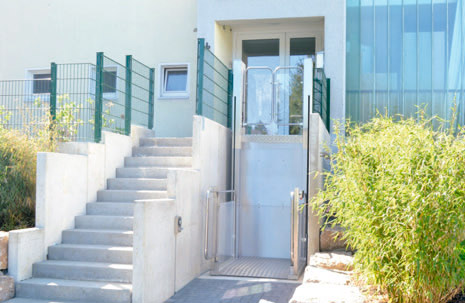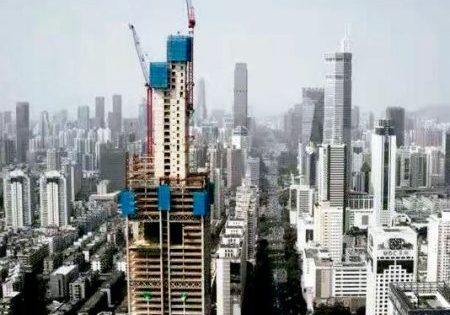Clean and Convenient
Jan 1, 2021

Newest offerings focus on user health, accessibility, construction technology and more.
Escalator Handrail Cleaning System
Seattle-based Thomsen’s Manufacturing Dual Handrail Cleaning System is a universal dolly-based device designed for compactness and simplicity. Non-motorized, it attaches to the moving escalator to remove dirt, grime and bacteria from the handrails. Specially designed microfiber cleaning pads (reversible and good for 200 washings) attached to molded pad holders clean them and apply a 24-hr window of protective antimicrobial film that kills 99.999% of all pathogens, including COVID-19, the company says.
Additional benefits include greater handrail elasticity (for improved longevity) and ease of use, though Thomsen’s teaches handrail adjustments and trains service companies (via Zoom) in proper operation techniques. The nontoxic and biodegradable chemicals applied are proven to not harm the handrail, based on having passed a five-day soak test and microbial testing. The product is patented in the U.S., Europe, Japan and China. Its steel frames are backed by a lifetime warranty.
Copper-Infused Polyolefin Sheets
Palmer Pads of Boston has introduced Palmer Copper Infused Polyolefin. The self-adherent product is intended for elevator button panels, door handles and other surfaces in constant use. Considered an “adhesive backed protective,” it can be cleaned with any normal sanitizing product without a reduction of its effective life. The company informed that copper has been scientifically proven to kill bacteria and viruses.
The product is sold three ways:
- By the meter
- In rolls approximately 15.75 in. X 10 m
- In a 40-cm X 1-m sheet
Cleaning Prep for Doors
The Peelle Co. of Smithtown, New York, and Brampton, Canada, has introduced Ready-Clean Options for its freight elevator/goods lift doors. They are designed to help mitigate the spread of germs and bacteria. First is “Washdown” equipment made of stainless-steel and moisture-resistant components the company says is “ready for intense washdown.” “Wipedown” has a stainless-steel fascia on the exposed side of the landing and car doors to “provide an easy-to-clean wipedown service.”
Accessibility Lifts
Herkules Liftwerk of Kaufungen, Germany, has been producing wheelchair lifts with rises of up to 3 m since 2013. The ISO 9001-certified lifts come in 16 different types, including the new open-platform lift Atlas 3000. Made of stainless steel and aluminium, it can carry up to 385 kg with a speed of up to 0.15 m/s. Automatic double-winged doors on the upper and lower exit are standard. Its platform size is 1,100 X 1,400 mm with a narrow total width of only 1,245 mm. It uses a double gear belt with a counterweight designed for silent, vibration-free operation.
KONE Platform Builds on Touchless Access
KONE has launched Office Flow™, a platform for offices, high-rise buildings and commercial developments that improves how people move in a lobby or from floor to floor. Office Flow combines new connected services for elevators, access management and adaptability for the lifetime of the building to meet evolving needs for smart and sustainable high-rise buildings. It uses KONE Mobile Experience, KONE Access and KONE Destination to provide touchless access and predictive elevator calling integrated with mobile devices, so key cards and tags are not needed. It features a newly designed destination control system, visitor management and guidance to reduce waiting and journey times. It can be adapted to meet the aesthetic design of a building, optimize traffic patterns and increase safety for tenants, employees and guests.
Office Flow uses open application programming interfaces (APIs) that allow easy integration of new applications and different types of equipment and services, which can be added as needed. As organizations look to improve office well-being, reduce their environmental footprint and create new and smarter workplaces, the APIs allow secure connection of elevators with a growing range of solutions, such as service robots, navigation apps, smart office and visitor-management solutions. These interfaces also allow integration of customer-branded applications.
Landing Door System
MEILLER Aufzugtüren GmbH of Munich, Germany, has made its active landing door system available. The product has its own drive with motor, transformer and “intelligent” door control system. The “intelligent” aspect, the company says, makes it possible to equip the landing and car doors with an optical coupling so the two doors move synchronously. The car door assumes the role of “master,” while the landing door acts as “slave.” If one of the doors is blocked during opening or closing, it reverses automatically. The reversal is transmitted to the other door via the optical coupling (IRcom sensor) so that it reacts simultaneously and synchronously.
Since driven landing doors do not have their own closing weight, the EN 81 requirement that landing doors must be self-closing is realized via an automatic forced-closing mode. These doors must have an emergency (uninterruptible) power supply to ensure they close and lock themselves. The range of powered active landing doors consists of two-panel center-opening, two-panel side-opening and four-panel center-opening doors. They are designed to be configured with almost all door panel executions, door sills and frame designs.
New Construction Hoist for Elevator Shafts
Alimak of Skellefteå, Sweden, has launched the new Alimak LSH construction hoist in China. Designed for use inside elevator shafts during building construction, the hoist can serve “the highest floors” of projects and “can be installed quickly with jumping operations doubling in efficiency,” the company touted. Its internal size is 1.8 X 1.5 m and 2.8 m tall. Its cabin can transport multiple workers or goods up to 2000 kg. Its rack-and-pinion technology precludes the need for a counterweight or machine room. Before being dismantled, it can also support the installation of elevator guide rails inside the shaft. The Alimak LSH can then be dismantled by tower crane upon completion of the construction work if the shaft is still open at the top. If that is not the case, the bolted design of the hoist still allows for easy dismantling and removal when the shaft is already closed.
The product has safety rails and fall protection on its roof. It is also equipped with a large-display, stainless-steel control panel and a 7-in. touchscreen with protective glass and IP54 ingress protection. Alimak’s “intelligent hoist monitoring system” delivers real-time hoist status information.
Touchless Control Solutions
thyssenkrupp Elevator has launched several touchless control solutions for elevators. Touchless Call and Elevator Pass are based on QR code technology to enable users to control and operate the elevator via smartphones or wearables. With online and offline usage features, they are applicable across a wide variety of segments, including offices, hotels, hospitals and residential buildings. Both are available for elevators from thyssenkrupp Elevator and other manufacturers. Touchless Call uses QR codes placed at each landing and inside the cabin. Passengers can use these to operate the elevator via a virtual control panel on their smartphones without having to touch buttons.
Elevator Pass operates like an airplane boarding card. QR codes can be generated anytime via an app, or received via email, text message or in paper form. The user then scans this code at a reader installed at the landing, and the elevator calls are generated automatically for the origin and destination floors. The solution was designed to be installed easily and does not require the use of an additional app. If the QR codes elevators within a facility need to be changed, new ones can be easily created and instantly override the previous codes. No internet connection or smartphone is required.
Get more of Elevator World. Sign up for our free e-newsletter.







